The History of the 'Great Builders',Solomon's Temple

Westminster Abbey church originally was a Benedictine monastery, but refounded as the Collegiate Church of St. Peter in Westminster by Queen Elizabeth in 1560. In legend, an original small church had been built as Thorney, but said to have been miraculously consecrated by St. Peter. It was then remodeled in 960 A.D. by St., Dansten. St. Edward, built a new church there in 1065, but was torn down and replaced by Henry III with an abbey church. Begun in 1376 was its rebuilding in Noramti Style by Henry Yevele until Tudor times. New chapels were added, banners, and finally the Western Towers. Last restorements were made by George Gilbert Scott in 1867 - 1890. Tradition since William the conqueror, It was for all soveirgn to be crowned there, and buried there, such as the tomb of George III. This is the only remaining stone work from Saxton England, which is in the undercroft. . from the York Rite handbook, 1978.
The Dionysiac Architects
The decendents of Tubal Cain, The Dionysiac Architects, as they were called, constituted an ancient society. Its principals and doctrines were much like the modern freemasons. They were an organized body of builders bound together by their secret knowledge of geometry.
The following is from the pages of Masonic Legends by Roderick H. Baxter
It may be proven that all the sciences of the world are grounded on the science of Geometry, for there is no trade or craft which does not work by mete or measure, nor does man buy or sell anything except by weight or measure, and especially do ploughmen and tillers of the soil work by the science of Geometry. None of the other sciences can enable man to carry on his trade or craft in such a way, wherefore we argue that Geometry is the worthiest of all sciences.
We shall now tell you how this science was begun. According to the fourth chapter of Genesis, before Noah's flood, there was a man called Lamech who had two wives, one called Ada and the other Zillah. The first wife Ada bore him two sons, Jabal and Jubal, and the second wife Zillah bore him a son and a daughter, Tubal-Cain and Naamah. These four children found the beginning of all the crafts in the world. Jabel, the eldest son, found the craft of Geometry, and he was the first person to divide lands and flocks of sheep and lambs, and he was also the first to build a house of wood and stone.
Jubal found the craft of Music, Tubal-Cain the craft of the Smith and Naamah the craft of Weaving. Now these children knew that God would take vengeance upon the earth, either by fire or water, and in order that their discoveries might be preserved to future generations they wrote them upon two pillars of stone; one of marble, which would not burn in fire, and the other of lattress, which would not drown in water.
The Old Charges of the cathedral builders, going back to the Regius Manuscript, written about 1390, generally conform to the rules and regulations of the modern fraternity some 300 years later. Wallace McLeod has shown that by about the year 1520, when the "Standard Original of the Old Charges" appeared, the Masonic custom of mutual support and charity had been codified into a written regulation.
And also that every Mason shall receive and cherish strange Fellows when they come over the country, and set them to work, as the manner is; that is to say, if they have mould stones in place, he shall set him a fortnight at the least on work, and give him his pay; and if he have no stones for him, he shall refresh him with money to the next Lodge.
Scottish lodge records from the transitional period definitely support the evolution of stonemasons' guilds into gentlemen's clubs, though similar English records are completely lacking. The early lodges encouraged convivial banquets, philosophical debates, and scientific discourses. Only two topics of discussion were forbidden in lodge then (as they continue to be forbidden today): religion and politics.
Some Masons, more enthusiastic than discerning, have traced Freemasonry directly to King Solomon's Temple and from there to Egyptian pyramids and on back to any civilization that built with stones. Masonic origins also have been sought in other groups, like the Knights Templar or the Rosicrucians or the Bavarian Illuminati (or sometimes even Secret Adepts from Atlantis!).
John Hamill presents an excellent summary of the various theories of origins in his 1994 book, The History of English Freemasonry. He suggests "the possibility that the originators of speculative Masonry clothed themselves in the appearance of an operative organization or guild to cloak activities and ideas which, at that time, it was impossible to practice openly." These activities could have been opposition to the intolerance of state politics and religion. He also offers the hypothesis of Andrew Durr which approaches the origins from the charitable rather than the philosophical aspect.
This sees Freemasonry as a development of the growing self-help movement in the seventeenth century. With no State Welfare system, those who fell sick or on hard times had to rely on local charity and the rigid working of the Poor Law. Different groups of trades began to make their own arrangements. Meeting convivially in inns and taverns, they kept a box into which members paid "dues" at each meeting and from which members could draw money in times of need. From this practice they became known as Box Clubs. Initially they were reserved to members of a particular trade, and there is evidence that they used primitive initiatory rites. It also seems that, like Scottish operative lodges, the Box Clubs began to admit members not connected with their particular trade. The possibility has been raised that Freemasonry originated as just such a Box Club for operative masons which later began to admit members of other trades.
While there is no agreement on the actual origins of
Freemasonry, the end results are clear: a worldwide fraternity
teaching borderless brotherhood, moral improvement, mutual
support, religious toleration, civic betterment, freedom of
thought, and universal charity. This volume will concentrate
on the latter aspect of the Ancient, Honorable Fraternity of
Free and Accepted Masons.
all above from: http://www.srmason-sj.org/mp2/newpage2.htm
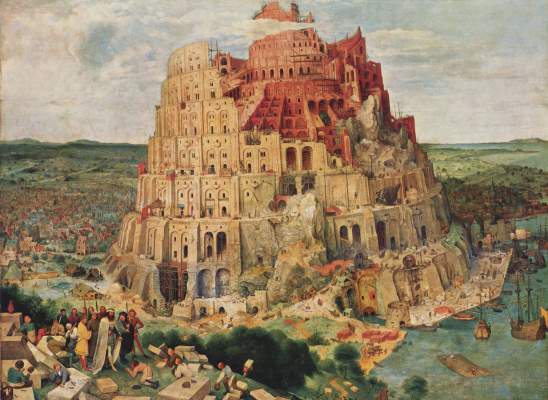 At the building of the Tower of Babel, masonry was in
great repute, and Nimrod, the King of Babylon, was himself a Mason and a lover of the craft, so that
when Nineveh and other cities of the East were about to be built, he sent thither three score
masons at the request of his cousin, the King of Nineveh, and when they went forth he gave
them a Charge in this manner:-- That they should love each other truly, in order that no
discredit should fall on him for sending them, and he also gave them a charge concerning their
science. These were the first Masons who ever received any charge.
At the building of the Tower of Babel, masonry was in
great repute, and Nimrod, the King of Babylon, was himself a Mason and a lover of the craft, so that
when Nineveh and other cities of the East were about to be built, he sent thither three score
masons at the request of his cousin, the King of Nineveh, and when they went forth he gave
them a Charge in this manner:-- That they should love each other truly, in order that no
discredit should fall on him for sending them, and he also gave them a charge concerning their
science. These were the first Masons who ever received any charge.
At a later date when Abraham, with his wife Sarah, went into Egypt he taught the seven sciences to the Egyptians. In these times it happened that many Lords and other great men of the realm had so many sons, some by their wives and some by other ladies, for that is a hot country and plenteous of generation, that they had not sufficient means to maintain them.
"So the King of the Country called a Council together and caused a parliament to be held to ascertain if any scheme could be devised to remove the difficulty. After full consideration they issued a proclamation that if anyone could inform them of any cunning art or science which would be of any avail he should be richly rewarded. Euclid, therefore, came before the King and his Council and offered, on condition of being appointed by commission to rule over them, to teach their sons the seven liberal sciences."
"The commission having been granted, Euclid took these Nobles' sons and instructed them in the science of Geometry and how to apply the knowledge to all manner of worthy works, such as the building of castles, churches, manors, towns and houses, and he gave them Charges similar to those which Nimrod had given in Babylon, with the addition of others which would take us too long to describe; and he made them swear a great oath, which men used at that time and gave them reasonable wages that they might live honestly. And he also arranged that they should assemble annually in order that they might take counsel together and settle any points in dispute, and how best generally to advance the interest of the craft."
"Long afterwards, when the Children of Israel were come into the Land of Behest, which we now call Canaan, King David began to build the Temple of the Lord, and he loved Masons well and gave them Charges as had been done in Egypt. And after the death of David, his son Solomon completed the temple which his father had begun, and he sent for masons into divers towns and countries, and gathered together twenty-four thousand men, of whom one thousand were ordained to be governors of work. And there was a King of another country whose name was Hiram, and he loved King David well and gave him timber for his work, and he had a son name Aymon, who was a master of Geometry and chief of all Masons and of all graven and carved work belonging to the Temple, as related in the First Book of Kings."
"Skillful craftsmen walked abroad in different countries, some to learn more science and others to spread the knowledge they had already gained, and it happened that there was a curious craftsman named Naymus Graecus who had been at the building of King Solomon's Temple, and he went to France and there taught the craft to Charles Martel, who afterwards became King of that country. Charles took upon himself the charges of a mason, and for the love he bore to masons he set many of them to work and gave them good wages and ordained for them an annual assembly as previously related for masons in Egypt."
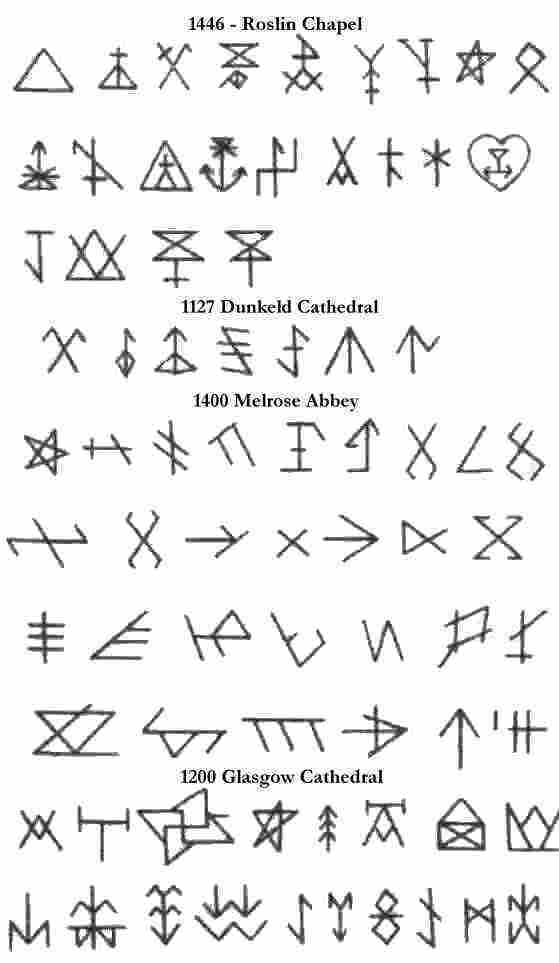 England at that time stood void of any charge of Masonry, but when St.
Amphibal came out of France he converted St. Alban to Christianity.
The King of England at that time was a pagan, and he walled the town of
Veralum, which is now called St. Albans, round about,
and St. Alban, who was a worthy Knight, was chief steward to the King,
and had the government of the realm and also the making of all walls,
towers and other works, and he loved masons well and cherished them
much and made their pay right good, considering the times, for he
gave them thirty pence a week with three-pence a day for their noon-findings,
for at that time a mason took but a penny a day and his meat,
and he gave them charges which St. Amphibal had taught him and they
differ but little from the charges in use at this day.
England at that time stood void of any charge of Masonry, but when St.
Amphibal came out of France he converted St. Alban to Christianity.
The King of England at that time was a pagan, and he walled the town of
Veralum, which is now called St. Albans, round about,
and St. Alban, who was a worthy Knight, was chief steward to the King,
and had the government of the realm and also the making of all walls,
towers and other works, and he loved masons well and cherished them
much and made their pay right good, considering the times, for he
gave them thirty pence a week with three-pence a day for their noon-findings,
for at that time a mason took but a penny a day and his meat,
and he gave them charges which St. Amphibal had taught him and they
differ but little from the charges in use at this day.
Soon after the death of St. Alban grievous wars disturbed the realm and the good order of Masonry was destroyed, until the time of King Athelstane, who brought the land to rest and peace and erected many abbeys, castles, and other buildings, and he had a son called Edwin, who loved Masons even more than his father did, and was a great practiser of Geometry and communed much with Masons, and he was afterwards made a Mason himself, and he obtained from the King, his father, a charter that they might hold every year an assembly wheresoever they wished within the realm, that they might correct any faults, errors, or trespasses concerning their craft.
Edwin himself presided over a great assembly of Masons at York, and he there made Masons, and he ordered all who had any writing concerning masonry to produce them, when some were found to be in Latin, some in Greek, some in French and some in other languages; but the meanings were all one, and he caused a book to be made thereof telling how the craft was found, and he commanded that it should be read whenever any Mason should be made and that he should be given his charge.
At the centre of every Lodge, upon its Altar, there may be seen the three Great Lights of Masonry -- the Holy Bible, the Square and the Compasses. The Compasses enable a builder to lay out the ground-plan of his building; the Square enables him to erect the uprights of his structure; the Bible furnishes him with the blue-prints of the Temple he hopes to construct.
( Builders ) In some respects, the Bible should be regarded as a Book about builders. It tells about a Holy Race whose builder was Abraham, and a Holy Law whose builder was Moses, and a Holy Temple whose builder was Solomon, and a Holy Church whose builder is Christ, and a Holy Communion -- the Kingdom of God -- whose builders are the apostles, the evangelists and the missionaries, and a Holy city, with gates of pearl and streets of gold, whose builder and maker is God. All of these pre-figure or fore-shadow the modern builder about whom Oliver Wendell Holmes writes, in his poem, "The Chambered Nautilus."
 "Build thee more stately mansions, O my soul
"Build thee more stately mansions, O my soul As the swift seasons roll!
Leave they low-vaulted past!
Let each new temple, nobler than the last,
Shut thee from heaven with a dome more vast
Till thou at length art free
Leaving thine outgrown shell by life's unresting sea!
The Templar's Architectural Skills
"On the other side of the palace [i.e., the Al-Aqsa Mosque] the Templars have built a new house, whose height, length and breadth, and all its cellars and refectories, staircase and roof, are far beyond the custom of this land. Indeed its roof is so high that, if I were to mention how high it is, those who listen would hardly believe me." - Theorderic (1174)
"Clearly he had regarded the Templars' architectural skills as almost supernaturally advanced and had been particularly impressed by the soaring roofs and arches that they had built ....Soaring roofs and arches had also been the distinguishing features of the Gothic architectural formula as expressed at Chartres and other French cathedrals in the twelfth century - cathedrals that...were regarded by some observers as 'scientifically...far beyond what can be allowed for in the knowledge of the epoch' [Louis Charpentier, The Mysteries of Chartres Cathedral]." "...What if, in their excavations on the Temple Mount, they had unearthed scrolls, manuscripts, theorems or blueprints relating to Solomon's Temple itself?
What if these discoveries had included the lost architectural
secrets of geometry, proportion, balance and harmony that had
been known to the builders of the pyramids and other great
monuments of antiquity? And what if the Templars had shared
these secrets with Saint Bernard in return for his enthusiastic
backing of their order?" -
Graham Hancock, The Sign and the Seal
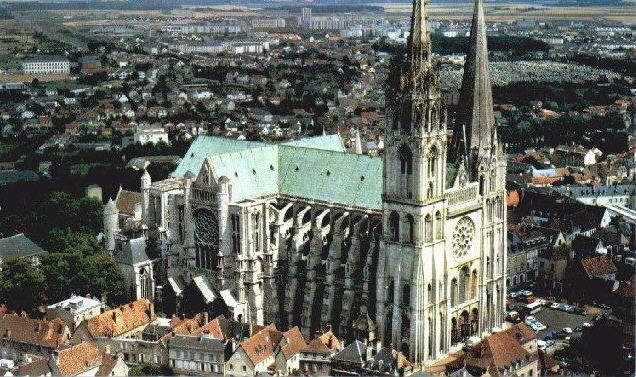 St. Bernard, the patron of the Templars, "played a formative
role in the evolution and dissemination of the Gothic architectural
formula in its early days (he had been at the height of his powers
in 1134 when the soaring north tower of Chartres cathedral had been
built, and he had constantly stressed the principles of sacred
geometry that had been put into practice in that tower and
throughout the whole wonderful building)." "Gothic architecture...
had been born at Chartres cathedral with the start of construction
work on the north tower in 1134....
St. Bernard, the patron of the Templars, "played a formative
role in the evolution and dissemination of the Gothic architectural
formula in its early days (he had been at the height of his powers
in 1134 when the soaring north tower of Chartres cathedral had been
built, and he had constantly stressed the principles of sacred
geometry that had been put into practice in that tower and
throughout the whole wonderful building)." "Gothic architecture...
had been born at Chartres cathedral with the start of construction
work on the north tower in 1134....
In the years immediately prior to 1134 Bernard had cultivated a particularly close friendship with Geoffrey the Bishop of Chartres, inspiring his with an 'uncommon enthusiasm' for the Gothic formula and holding 'almost daily negotiations with the builders themselves'." When asked "What is God?", Bernard replied "He is length, width, height and depth." "The entire edifice had been carefully and explicitly designed as a key to the deeper religious mysteries. Thus, for example, the architects and masons had made use of gematria (an ancient Hebrew cipher that substitutes numbers for the letters of the alphabet) to 'spell out' obscure liturgical phrases in many of the key dimensions of the great building. Similarly the sculptors and glaziers - working usually to the instructions of the higher clergy - had carefully concealed complex messages about human nature, about the past, and about the prophetic meaning of the Scriptures in the thousands of different devices and designs that they had created." (For example a tableau in the north porch depicts the removal, to some unstated destination, of the Ark of the Covenant - which is shown placed upon an ox-cart. The damaged and eroded description, "HIC AMICITUR ARCHA CEDERIS" which could be "Here is hidden the Ark of the Covenant".)
"In 1139, Pope Innocent II (whose candidacy, incidentally,
had also been enthusiastically backed by Saint Bernard),
granted the order a unique privilege - the right to build
their own churches. This was a privilege that they subsequently
exercised to the full: beautiful places of worship, often
circular in plan like the Temple Church in London, became
a hallmark of Templar activities." -
Graham Hancock, The Sign and the Seal
"The great effort of the Order was the transfer of
funds and men to the east. They erected numerous building
in the west - preceptories, churches, granges - for training
and administration, but these were humble and utilitarian
in nature, with a few exceptions. There was no standard
form of Templar church: a very few, curricular or polygonal,
recalled the shape either of the Dome of the Rock at Jerusalem
(the 'Temple of God' of the Templar seal) or of the octagon
of the Church of the Holy Sepulcher at Jerusalem. But most
Templar churches were orthodox apsidal structures." -
Peter Partner, The Murdered Magicians
Amongst the builders of the Bible an honoured place must be accorded a man named Nehemiah. In the halls of fame of the Jewish people, there is no name which stands higher or shines brighter than his.
He is blood-brother to some of the best amongst the great
and some of the greatest amongst the good: Spinoza, the philosopher, Rothschild,
the financier, Mendelssohn, the musician, Disraeli, the
statesman, Albert Einstein, the mathematician, Chaim Weizman, the scientist, and Jonas Salk,
the physician. Nor should we overlook the names of religious leaders such as David,
the Psalmist, Isaiah, the prophet and Paul the missionary. too often
we say, by our attitudes if not by our words, "How odd of God,
to choose the Jews." To which a Jew has replied,
"Oh no it's not; God knows what's what." god not only knows
"what's what" but who's who." That is why under God, the Great Architect
of the Universe, Nehemiah was the right man, in the right place, at the
right time. Neither prophet nor priest, he made his mark as a layman,
the kind of person of whom it may be said:
"And moving up from higher to higher,
Becomes on Fortune's crowning slope
The pillar of a people's hope,
The center of a world's
desire."
the above from...BLUE-PRINTS FOR BUILDERS by Bro. J. Gordon Jones
In the work of building, men do not live by bread alone but by such soul-stirring, heart-warming words as faith, hope and love, which come from the mouth of God. In these days, too many people are suffering from what may be called "psycho-sclerosis." do you know what sclerosis of the liver is? It is hardening of the liver. And, do you know what arterio-sclerosis is? It is hardening of the arteries. Well, psycho-schlerosis is hardening of the mind, and of the thoughts, and of the feelings. The very best cure for psycho-sclerosis is encouragement and enthusiasm; they cause you to "come alive" to your finger tips. they give you inward resources of "pep", and "punch" and spiritual power.
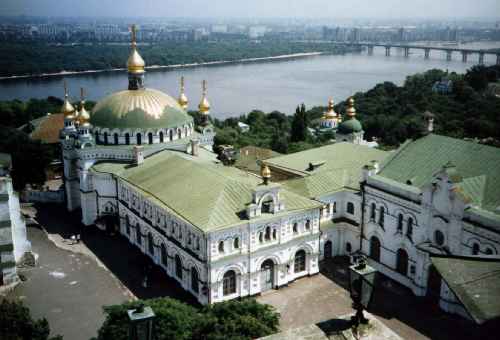 This is the cathedral in Kiev, Capitol of Ukraine,
built in the 13th century or possibly earlier.
This is the cathedral in Kiev, Capitol of Ukraine,
built in the 13th century or possibly earlier.
One of the most inspiring buildings ever erected by Masons of medieval times is Milan Cathedral in northern Italy. It has hundreds of spires and more than a thousand statues on its roof-top. The whole edifice, carved out of marble, with the great Alpine peaks in the background, gives one the impression that the builders have just broken off one vast piece of marble from a shoulder of the Alps and have carved a cathedral out of it. There are few things in the world more glorious than the "frozen music" of Milan Cathedral, and few things about Milan Cathedral more impressive than the kaleidoscopic colouring of its stained glass windows.
There were windows facing the west, which caught up the rays of the setting sun and transformed them into a thousand shades and colourings. There were images of the apostles and prophets and the angels of heaven. Out-towering them all, there was a vast representation of Christ Himself. All of this beauty in glass is the triumph of an old workman, whom some people considered mad, who took thousands of pieces of glass, and bound them together with the magic cement of his zest and his zeal. Milan is a constant reminder of the truthfulness of Emerson's saying "Every great and commanding moment in the annals of the world is the triumph of some enthusiasm."
A Worldwide Tour of Churches, Cathedrals and Monasteries
Milan cathedral; right.
 The Cathedral was many
years in building; after the foundations were laid,
one by one the walls were erected, and bit by bit the
buttresses were put into place. At that time an
old workman was seen in the vicinity of the Cathedral,
holding in his hand small bits of coloured glass. He would lay them in patterns on
the roadways near the Cathedral. He would compare their colours with the flowers in
the near-by gardens. He would hold up pieces of glass in the sunlight
to let the sun's rays shine through them.
The Cathedral was many
years in building; after the foundations were laid,
one by one the walls were erected, and bit by bit the
buttresses were put into place. At that time an
old workman was seen in the vicinity of the Cathedral,
holding in his hand small bits of coloured glass. He would lay them in patterns on
the roadways near the Cathedral. He would compare their colours with the flowers in
the near-by gardens. He would hold up pieces of glass in the sunlight
to let the sun's rays shine through them.
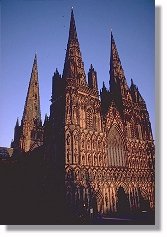 Lichfield Cathedral, left..Though the interior of this cathedral was badly damaged by the
iconoclasts, the elaborate West Front (c. 1265-1320, with
Victorian restoration of the lower tier) remains relatively
unscathed. While most medieval cathedrals retain their high
towers, few retain their spires, and in this repect, along with
the glorious West Front, Lichfield is a rare gem. The two
western spires here rise in excess of 190 feet, and the central
spire rises in excess of 250 feet.
Lichfield Cathedral, left..Though the interior of this cathedral was badly damaged by the
iconoclasts, the elaborate West Front (c. 1265-1320, with
Victorian restoration of the lower tier) remains relatively
unscathed. While most medieval cathedrals retain their high
towers, few retain their spires, and in this repect, along with
the glorious West Front, Lichfield is a rare gem. The two
western spires here rise in excess of 190 feet, and the central
spire rises in excess of 250 feet.
Having looked at Nehemiah's plan of action, let us now examine his philosophy of life. It was his purpose to show his workers the larger significance of what they were doing. They were laying bricks; they were repairing the walls; they were rebuilding the city of Jerusalem. Jerusalem, however, is something more than a mark on a map of Palestine; it is a place-name in the geography of the soul. Jerusalem is the City of David, the place where David sang, "Lift up your heads, O ye gates; even lift them up, ye everlasting doors; and the King of Glory shall come in." (Psalm 24:9). Jerusalem is the home of Isaiah, the prophet who preached and promised that, "The ransomed of the Lord shall return, and come to Zion with songs and everlasting joy upon their heads; they shall obtain joy and gladness, and sorrow and sighing shall flee away." (Isaiah 35:10). Jerusalem is the City of Christ, the Master Builder, who said, "On this rock I will build my Church, and the gates of hell shall not prevail against it." (Matt. 16:18).
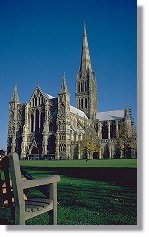 Salisbury
Cathedral: View of the West Front. The cathedral is renowned
for its 404-foot spire, the highest in England (and about a third of
the height of the Empire State Building). Construction
on the present Cathedral began in 1220 and the spire,
the last portion of the present Cathedral to be constructed,
took from 1285-1310 to complete. By medieval standards of
cathedral-building this was fast work, and to modern
eyes this is reflected in the relative uniformity
of both its floorplan and its predominantly Early
English style of gothic architecture.
Salisbury
Cathedral: View of the West Front. The cathedral is renowned
for its 404-foot spire, the highest in England (and about a third of
the height of the Empire State Building). Construction
on the present Cathedral began in 1220 and the spire,
the last portion of the present Cathedral to be constructed,
took from 1285-1310 to complete. By medieval standards of
cathedral-building this was fast work, and to modern
eyes this is reflected in the relative uniformity
of both its floorplan and its predominantly Early
English style of gothic architecture.
Shakespeare, in his play, "As You Like It," speaks about finding "tongues in trees, books in the running brooks, sermons in stones and good in everything." How true this is of Jerusalem! If her trees had tongues, they would speak of Christ, the Master-workman, who was crucified on a tree outside the city's walls. If her brooks were books, they would tell of a blind man who received his sight at the Pool of Siloam when Christ, the Master-healer, happened to pass that way.
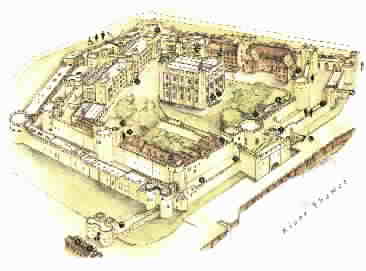 The Tower of London built in 1066 by Norman Masons. The walls were 15 feet thick at the base.
It's really more of what we would call a castle rather than a tower.
It is surrounded by a mote (now dry) and is still guarded by Yeoman Warders - or
"Beefeaters" as they are often called.
The Tower of London built in 1066 by Norman Masons. The walls were 15 feet thick at the base.
It's really more of what we would call a castle rather than a tower.
It is surrounded by a mote (now dry) and is still guarded by Yeoman Warders - or
"Beefeaters" as they are often called.
The builders and the Organization of the Operative Lodge
The Articles and Points, a compilation of masonic customs from the "Book of Charges," dating back to about 1360, are one of the earliest records of rules of conduct.
The Articles are directed chiefly to masters, i.e., to craftsmen in charge of a building operation; they are to be loyal to the lord, i.e., the employer, and not to waste his goods by giving more pay to any man than he may deserve, the price of corn and victuals being considered; no master is to take an apprentice of less than seven years, for the art cannot be learned in a shorter time; nor may he take an apprentice of bond blood, nor one that is maimed or physically incapable; like other masons, the apprentice is not to be unduly charged for, "that the lord of the place that he is taught may have some profit by his teaching"; a master is not to be a maintainer of night-walkers or robbers; he is, wherever possible, to dismiss an insufficiently skilled workman and to take a better in his place, "to the profit of the lord"; lastly, no master is to supplant another, for no man can so well finish a piece of work as he that began it.
The Points are directed to fellows, i.e., to workmen other than the master in charge. Such a workman must love God and the Holy Church and regard his fellows as brethren; he must be secret, not disclosing "the counsel of his fellows in lodge or chamber"; he must take his pay meekly at the time appointed and avoid quarrelling; if quarrels do break out between him and his fellows, the discussion must be postponed to the next holiday and then settled, for to pursue the matter immediately would mean hindering the building work and cause loss to the lord. The mason must keep the seventh commandment; the reason given for that, if not scriptural, may have been sound enough, namely, that breach of the commandment would lead to discord among masons. If a mason should be a warden, he should be a true mediator between the master and his fellows. Lastly, a mason who is more skilled than his fellows and sees one of them working wrongly, so that a stone is likely to be spoiled, should instruct him and help him to do the work properly, "that the more love may increase among them and that the work of the lord be not lost."
There is a suggestion that these rules existed to prevent disagreement among Masons, which would hinder the efficiency and quality of their work. It also traces the development of one element of the lodge, the Mason Word, which made the secrecy rule in particular a practical necessity.
...the Mason Word was first instituted to serve a strictly "operative" aim. That was to distinguish masons who were members of their trade organization, and to enable them to claim, at need, benefits in the way of employment and relief.
The Mason Word served to protect trained masons (and their families) against claims and competition from untrained stoneworkers, or "cowans," and from entered apprentices, who had not yet completed their training. In modern times, the secret work of the Masonic lodge is less important as a literal safeguard, but the symbolic protection remains.
If her stones were sermons, they would preach of Christ the Master-teacher who, from the Mount of Olives, looked down upon Jerusalem's gates and walls, and said, "O Jerusalem, Jerusalem -- how often would I have gathered thy children together, even as a hen gathereth her chickens under her wings and ye would not!" (Matt. 23:37). Such was the city where Nehemiah was teaching the workmen to see the larger significance of that which they were doing. In the course of the centuries this city's influence has reached out to every land, and has brought blessings to many people.
More Great Buildings On-Line This is a search engine, Key in Florence, Italy, or Westminster Abbey ect.
As you already have seen the connections emerging from the previous pages, here is the final, most critial connection of all. This is how after the history , the real story had to be changed to bring back the God of the people, 'Yehwah'.
Seqenenre was a Master, and was 'one with God' because he knew ; God's laws , the secret king making ritual , which included the practice of the 'resurrection' ceremony , he had the 'wisdom of God', which included the arts and sciences of building and architectonics, and the belief in the afterlife and immortality. He died protecting the secrets he knew.
What We have discovered through the research for this web site, is that the Old Testament was re-written in 580 BC after the Babylonian captivity of the Jews. Through the years of captivity, the senior figures from Jerusalem refined their thinking about their relationship with their god Yahweh, and slowly he became God with a capitol 'G' The important aim for them was to return to Yahweh in the hope that he would repair their ill-fortune, which they believed had arisen through their own failure to honor their God. The Enochian concept of sin being an external factor inflicted on people was replaced by a concept of sin that was considered to be the individual's own fault. The leading figure in this period of Jewish rethinking was Ezekiel, who proposed an idea of cleansing away sin that was to become very important.
The Phoenician era saw a shift in Canaanite religion, when a larger pantheon of gods became pushed aside in favor of previously less important, singular deities supported by ruling priest-kings. The first king of the Jews was Saul, who chose to call his son and successor 'Issh-baal ', which was a Canaanite name meaning 'man of baal', an indication of a non Enochian outlook for the new Jewish state. David inherited the privileges and obligations of the earlier Canaanite city kings as well as acquiring the priestly functions rooted in Canaanite tradition, which he inherited from Melchizedek, the king of Jerusalem.
The pre-eminence of the ancient Canaanite priesthood of Melchizedek over the ideas of Moses is born out by the history of the Jews. There is evidence that the Canaanite priestly family of Zodok officiated as priests of the Hebrew's God Yahweh. This indicated that the megalithic or Enochian religion survived to enter into Zadokite Judiasm, and its only real threat was from the new ideas brought to Isreal by Moses and his brother Aaron. Solomon inheriated these ideas.
The re-write of scripture was ordered to show these new concepts and goals. That makes it entirely possible for the contents of the re-write to be very different than the original by a wide margin. Meaning the Egyptian heritage of the people had to go and possibly some of the Enochian traditions too. This fact leaves the Dead Sea Scrolls being the Oldest original and complete biblically related documents presently known.
What has been translated of the scrolls is an amazing look back in time to the priesthood of the Judean community that was the nucleus of the Enochian concept brought to Israel by Moses. The Temple itself was perfectly Enochian. It faced due East aligned with the equinoctial sunrise across the Garden of Gethsemane and above the mount of olives. In front of its eastern-facing entrance were the two free-standing pillers of Boaz and Jachin: Boaz marked the sunrise of the summer soltice and Jachin, the winter soltice. This continued the 'henge' and underground Venus and sun alignment tradition of the Groved Ware people, the Enochian tradition of celebrating the equinoxes and the same rights of birth and re -birth that were also observed by the ancient Egyptians.
The priesthood that emerged from Babylonian capitity was mostly made up of Zadokite priests, although there were some who traced their lineage back to a ceremony held at Ithamar in Egypt where accommodations had been arrived at so that both groups - the Zadokite and the Enochians now declared a common ancestor in Aaron. The dead sea scrolls tell us that the Zodokite priesthood withdrew from mainstream activities when the Hasmonean kings claimed the office of high priest for themselves in 152 BC. They reteated in part, to Khirbet Qumran - a rocky outcroup overlooking the Dead Sea some eight miles south of Jericho.
It is believed that the 'secrets' and God's law remained intact but
the images were removed because they had become
more important than what they originally stood for.
Hiram Abiff became the new image and ideal of
what Seqenenre once was. Hiram became an Architect because of Enoch,
because of Thoth, but he also represented an innocent victim whos' courage
and suffering took him to Heaven and eternal life.
This drama in effect, came into being because of King Seqenenre Tao II,
called the 'WAY' and the King who was 'Lost'.
We are aware that Sequenere is
not mentioned in the degrees, but he fits with the pharoah's image of a
King that may have secretly worshiped one God and had
studied the Emerald tablets and practiced the original ancient religion.
We also suspect that Moses presided at the trial of the murders and Tao's funeral
and that story became the 22nd degree of the AASRF. This was changed
to be King Solomon so that the Egyptian memories
that began the 'mysteries', would effectively be forgotten. This may have came
about because Ezekiel intended to change everything that referred to Gods
and goddesses of an earlier time.
One reason is that Moses had susposedly 'sinned' against God,
so what Ezekiel taught was changed to suit the new religion of the Jews.
In this day of prominent christian, Musslum, Jewish and Islamic teachings, Jesus was not known
to have practiced the old religion of the Egyptians, but he did,
as did Moses and Solomon. A small sect retained the teachings and we
still have them. These teachings, in our opinion, deny the God YHWH as being the true God
so it becomes increasingly difficult to explain this because the christian
teachings came about from Jewish/Hebrew origins. However if you have been to
Passage page 6,
you see that Nimrod made the first masonic 'charges' and now the christians
and other religious groups call him the originator of a 'pagan' religion. We discovered this
wasn't the case at all and we feel that Nimrod caused a
revolt to get rid of worship to Yahweh because he knew he was a
false God. The phrase," He hunts not animals, but rather
the souls of men", was twisted to a dark meaning by the real followers of Satan.
The sons of Noah were not into 'pagan' religion, so there's no way Nimrod would have been either.
The corrupters came from the sons of Cain and they are the reason for the false religions of
the world. But Satan has the ability to blame the evil on everybody else so he convinced
the people to worship him in the name of Yahweh and they didn't know the difference.
No one could stop Ezekiel either but he is not important in Masonic lore any where that we can find.
Judiasm became the 'new' religion in the 'promised land', and the rest, such as worship to, baal or a goddess, were 'outlawed' and forbidden. The people who continued to practice these religious rites were called heathens. They continued to be murdered by the opposing factor because of their beliefs, but they, like many others, went 'under ground' and practiced what they believed in secret.
As we have discovered, what is termed 'heathen' to one may not be to another for obvious reasons. As the Eastern world has mostly been converted to Islam, the rest of us still have a different idea of what our religion should be. And we are sure that the Islamic population will fall and be annihilated when Christ returns. This, of course, will restore Israel to it's former grandeur and save the 'chosen people'. Some of us can't wait for this to happen, with ben Ladden causing those of us who love and cherish freedom, to fear for our lives.
Where did we get the information we refer to here and throughout this
site? Read for yourself.
Beginning with The Hiram Key.
More about Solomon's Temple on.. Missing Lessons
 |
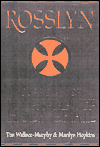 |
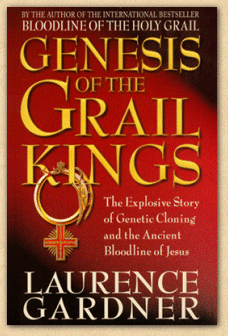 |
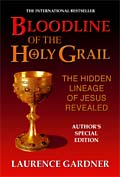 |
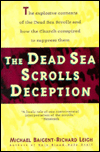 |
 |

|
 |
 |

|

|
 |
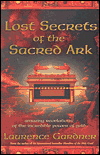 |
Search this site
Our search Engine does not search for the links in this site, only words in the text.
NO PART OF THIS SITE MAY BE COPIED OR REPRODUCED, IN WHOLE OR IN PART WITHOUT THE EXPRESS WRITTEN APPROVAL OF THE WEBMASTER..ę. COPYRIGHT 1999 - 2009 C.I.C.ALL RIGHTS RESERVED
This page has been visited Times since August 27th, 1999